We spent five days in the Kingdom of Bhutan, a small country with a population of around 740,000 people that is bordered by Tibet and India. Bhutan is called The Land of the Thunder Dragon. The Druk is the Thunder Dragon of Bhutanese mythology and a national symbol featured on the country’s flag. Bhutan is known for many unique things, including being the world’s only carbon negative country. They take environmental conservation and preservation of natural resources seriously and have policies in place to ensure forest land is preserved, more trees are planted than are removed, and that their energy production is renewable. Their largest export is hydroelectric power. They are also striving to have their country’s food production be 100% organic. Bhutan is the most pristine and green place we have been during our travels. When we arrived we noticed that there was no outdoor advertising anywhere and there seemed to be beautiful mountain views in every direction.
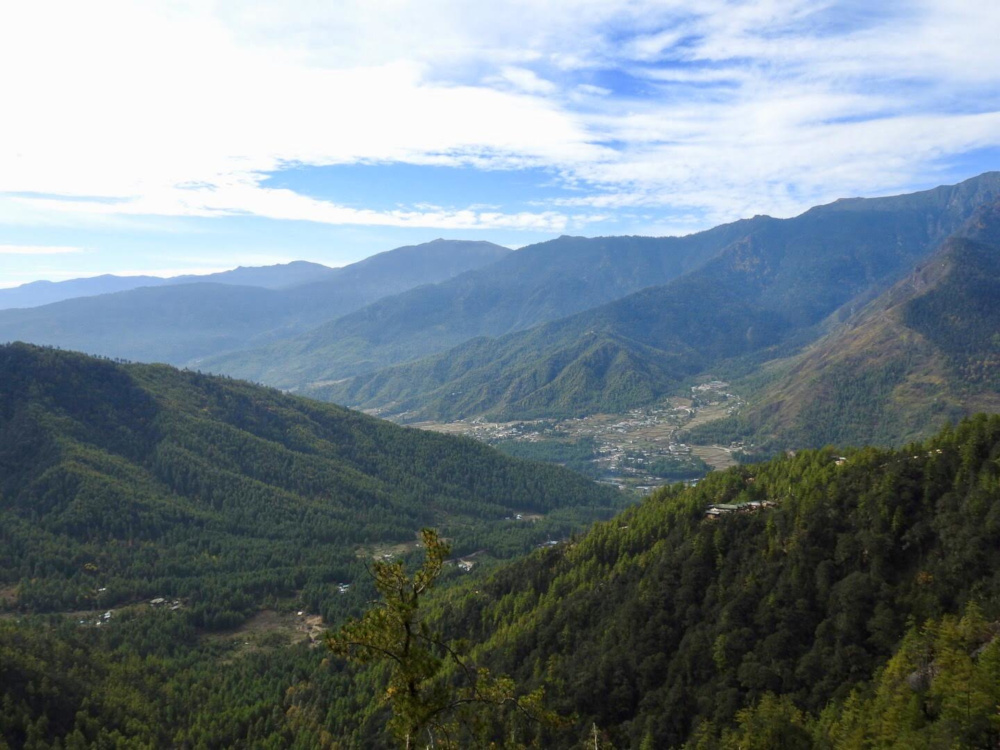
We were greeted at the airport in Paro by our guide Sonam and our driver Khundhu, who made up the local team showing us around during our visit. Americans and most foreign visitors are required to book a guided tour in order to visit Bhtuan and there is a minimum cost of $250 per person per day for tours. We limited our visit to five days in order to not completely blow the budget. I believe this minimum cost is their way of limiting tourism to a sustainable level by making it exclusive and generating significant revenue that benefits the country as a whole. We visited the areas of Thimpu, Punakha, and Paro during our short visit.
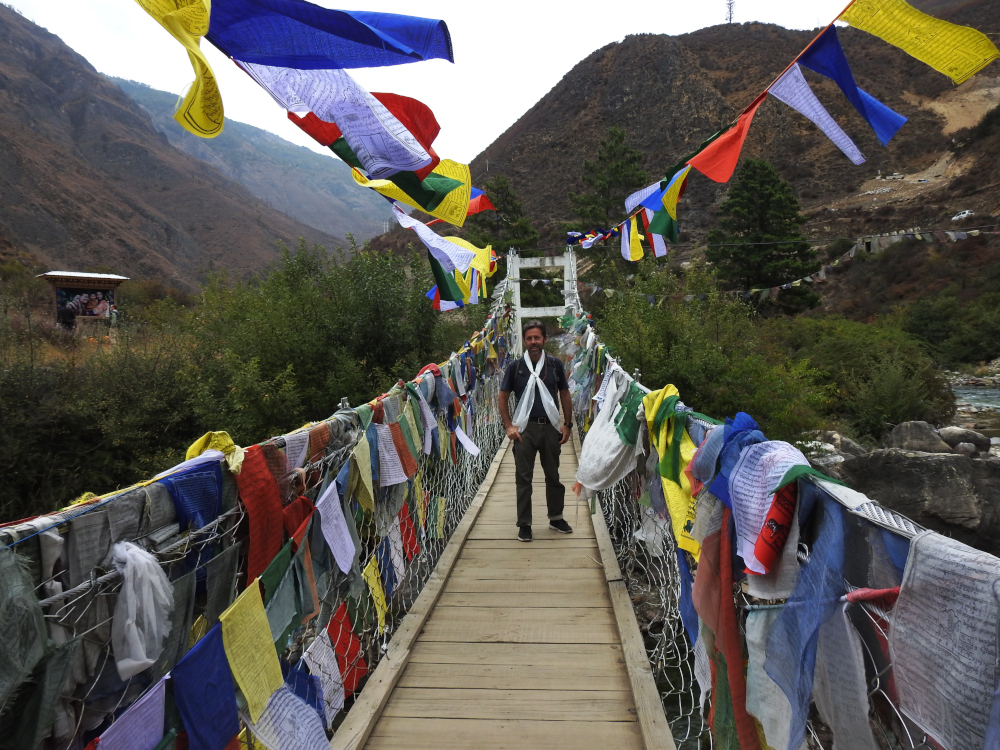
Our first stop after leaving the airport was at the Tachagang Lhahang Bridge, which was built around 600 years ago and was the first of many such bridges built in Bhutan. It is currently under renovation so a newer suspension bridge was built next to it that is used to cross the river and reach a small temple on the other side. We also visited a small paper factory where we saw paper being made completely by hand by local people using only tree bark and other natural materials.

We also visited a painting school were students are taught art skills such as painting, wood carving, and sculpture. All of these art forms are prominent all over Bhutan and it is amazing that all of these are taught to be done completely by hand. There seemed to be beautiful painting and woodwork present in most buildings in Bhutan, so there must be a demand for this type of artistic skill. All buildings and homes are built in the traditional Bhtuanese architecture style giving the cities and towns a unique and cohesive look.
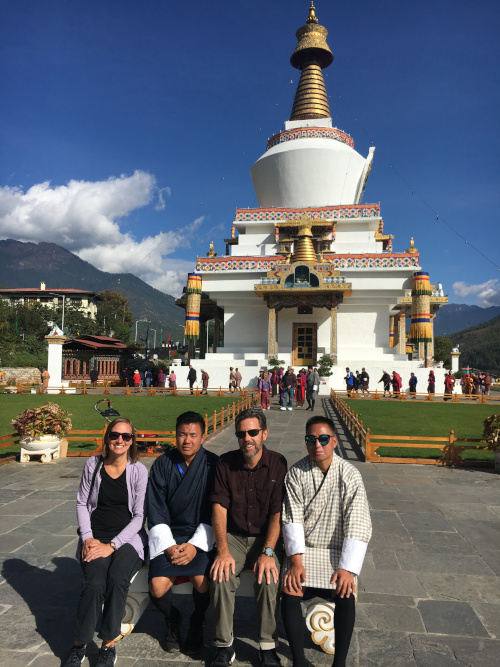
We visited the Memorial Stupa, which was built to honor Bhutan’s third King who died in his forties. Local people visit the stupa in their free time and walk around it in clockwise circles reciting prayers and whirling the large prayer wheels to earn merit and purify bad karma. Inside the stupa we saw and heard Buddhist monks performing rituals involving chanting and playing horns and drums. Photos and videos are not allowed to be taken inside any religious sites such as stupas, monasteries, and temples in Bhutan. A photo of us with our guide Sonam and driver Khundhu outside the Memorial Stupa is shown here. They are wearing the traditional Bhutanese dress men wear while they’re working.
We also visited a nunnery and stopped at a viewpoint to gaze at the Tashichho Dzong, a large Buddhist monastery and fortress that was built in 1216. It has been damaged by fires and had to be partially rebuilt to match its original design. It houses the throne room and offices of Bhutan’s King and his family’s palace is nearby.
Bhutan has a prime minister that oversees executive power and a King. The monarchy is loved and cherished by the Bhutanese people. There are prominent photos of the King and his family everywhere across the country, including along highways, inside temples, at hotels, and inside restaurants. They are quite photogenic as you can see in the photo below of a large outdoor sign featuring the King and Queen.
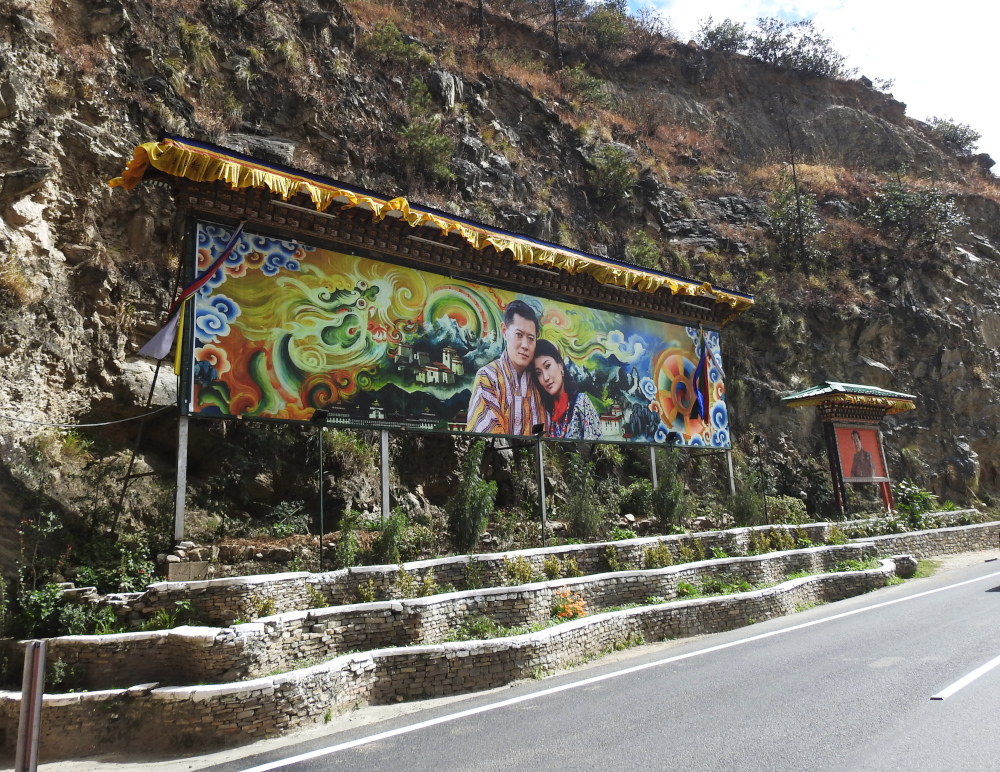
One morning we visited Buddha Dordenma where a gigantic bronze statue of Shakyamuni Buddha that is more than 170 feet tall is perched on a mountainside overlooking Thimbu, which is the capital of Bhutan and its largest city. Inside the statue’s ground level there are over 100,000 small bronze and gilded Buddha statues on shelves. People can purchase additional small statues to be housed here if they like.
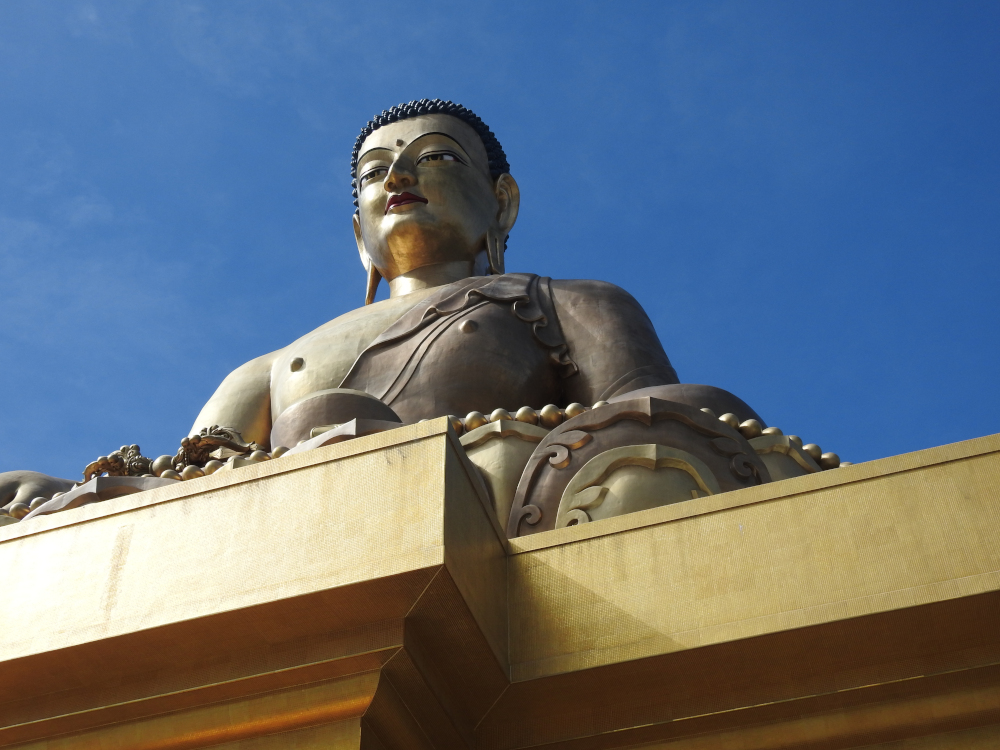
Construction of Buddha Dordenma was completed in 2015 so it is one of the newer Buddhist monuments we have seen anywhere. The giant Buddha is surrounded by smaller Bodhisattva statues and a huge flat terrace designed for mass prayer gatherings. The giant Buddha statue is said to emanate peace and happiness to the entire world.
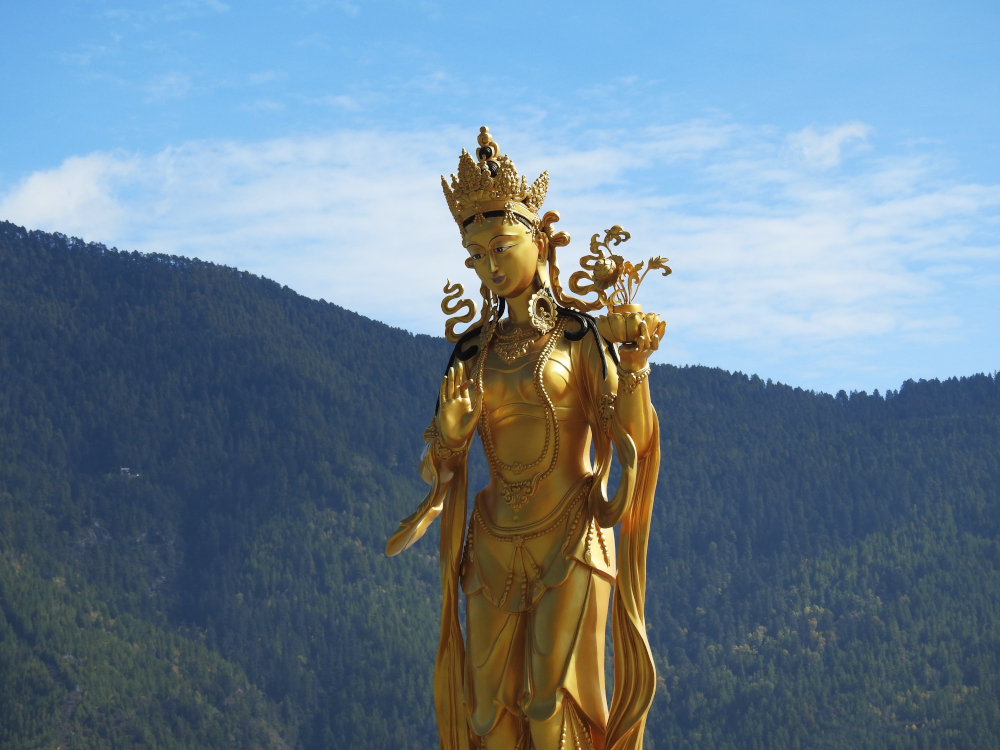
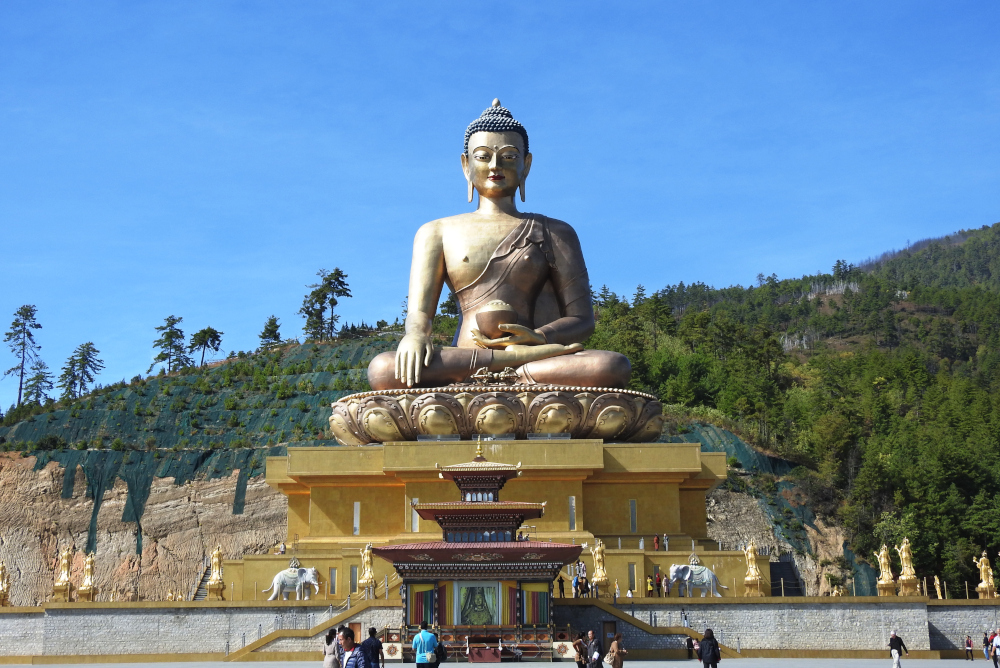
During the drive from Thimphu to Punaka, we went through the Dochula Pass, where a grouping of 108 stupas were built to memorialize and honor Bhutanese soldiers who were killed in a battle fought against terrorist insurgents from India in 2003. This spot has amazing views of the surrounding Himalayan Mountains as well as a popular cafe where we stopped to have some biscuits and tea. This spot is at a higher elevation and the temperature was much cooler than all the other areas we visited.

We also visited Chimi Lhakhang, which is also known as the Temple of Fertility. Many people come here to receive a blessing if they are having fertility issues. The temple is reached by a pleasant walking path through farming fields and a village. Inside the temple there is a photo album of many babies from all over the world who were born after their mothers received a blessing at the temple. Apparently their parents sent in the photos to the temple after the births. There is a large wooden phallus figure inside the temple that is used for the fertility blessings. This tradition comes from the “Divine Madman” who was a legendary enlightened Tibetan monk who helped spread Buddhism in the 15th century using bizarre and unorthodox ways of teaching. It is said he used imagery of the phallus to subdue demons and bless the people of Bhutan. There are phallus paintings on the buildings in the village surrounding this temple and numerous shops selling phallus shaped souvenirs. It is a little surprising and unexpected to see these all over this area if you are not aware of the local history. The phallus paintings on buildings and homes are meant to ward off bad spirits and malicious gossip. It is a unique custom.
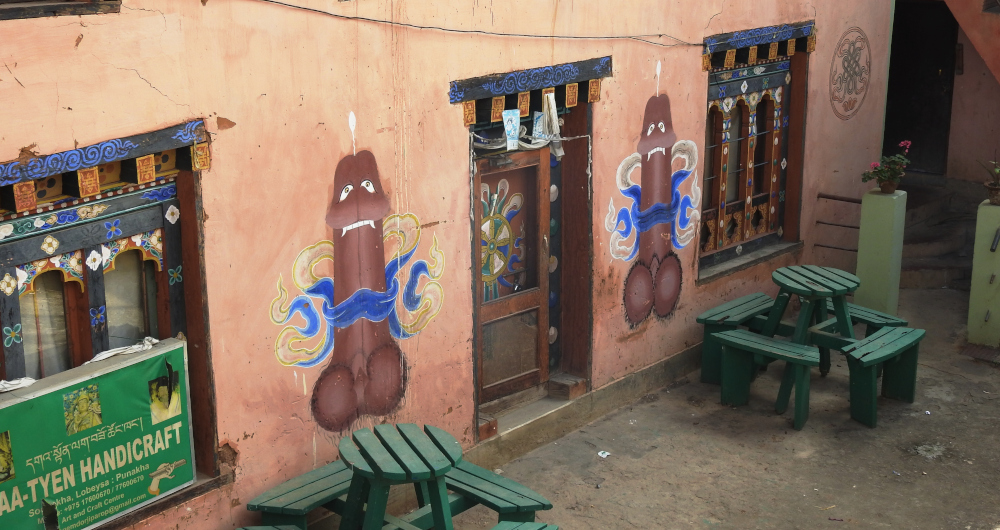
While in the Punakha district we visited the amazing Punakha Dzong, which is Bhutan’s second oldest and second largest dzong. A dzong is a traditional style Bhutanese fortress. This one is beautifully sited at the confluence of the Mo Chhu and Pho Chhu Rivers.
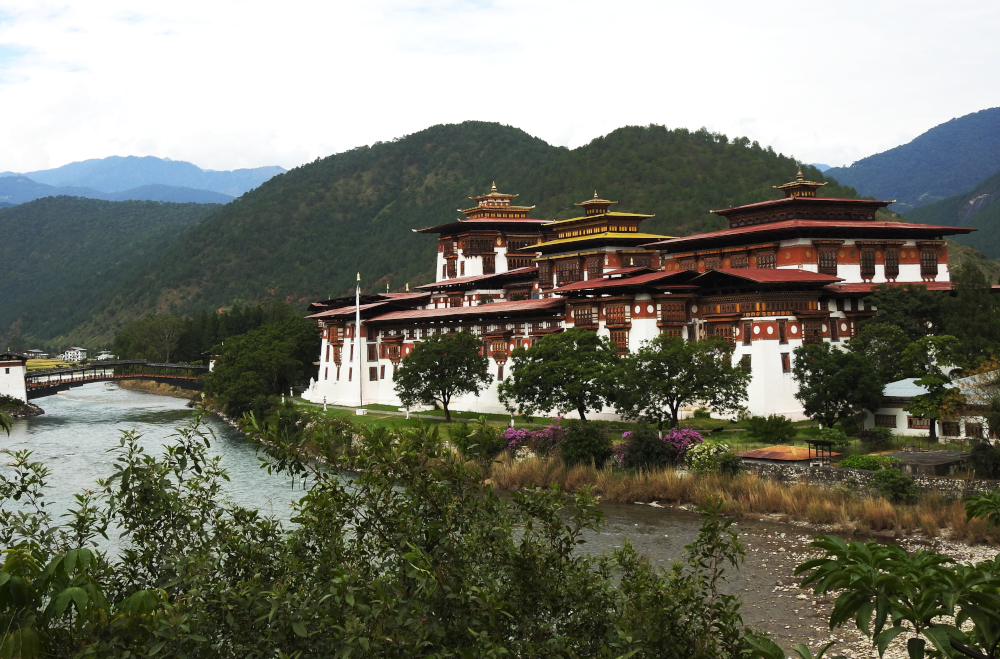
Inside the dzong’s assembly hall building there is an intricate series of murals that depict the life of Buddha and our guide went through the series with us in great detail. There is also a beautiful Wheel of Life miral representing cyclic existence. Most temples and monasteries in Bhutan feature the Wheel of Life on the wall somewhere.
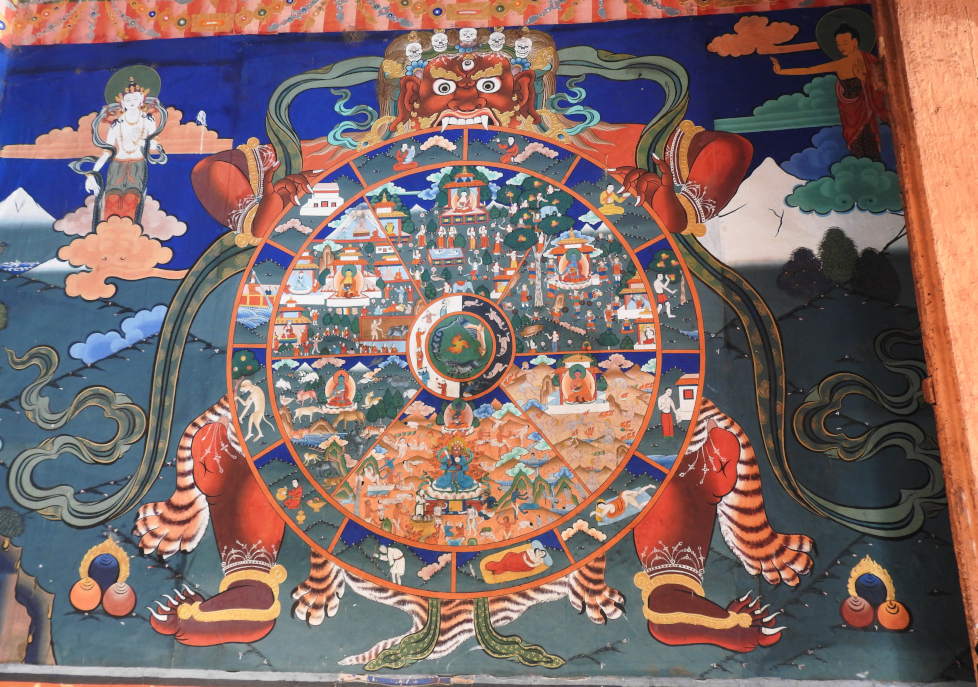
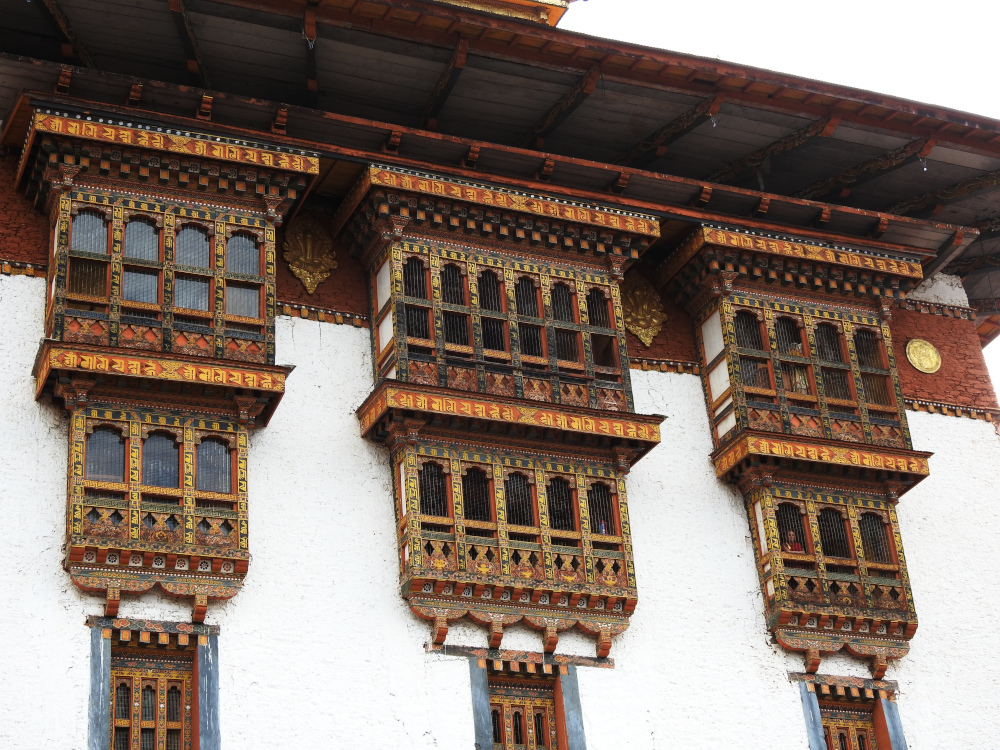
There is a room inside this dzong where all five of Bhutan’s kings have been crowned so it holds a very important place in Bhutan’s history and traditions. The entire compound is an impressive work of art that is still in use today for government administrative offices and a Buddhist school.
Our guide asked us if we wanted to try some river rafting in the Punakha district while we were there. We did not know rafting was even going to be an option during our visit but we decided to give it a try. Our driver Khundhu joined us and a rafting guide as we set off down the Mo Chu River. We put on the river at around 4:00 pm and the temperature had already dropped a bit. The river water was quite chilly but with the river having only class I and II rapids we did not get all that wet. It was more of a relaxing scenic float down the river that lasted just over an hour and we thoroughly enjoyed it. There is another river with larger rapids nearby for those seeking bigger water.
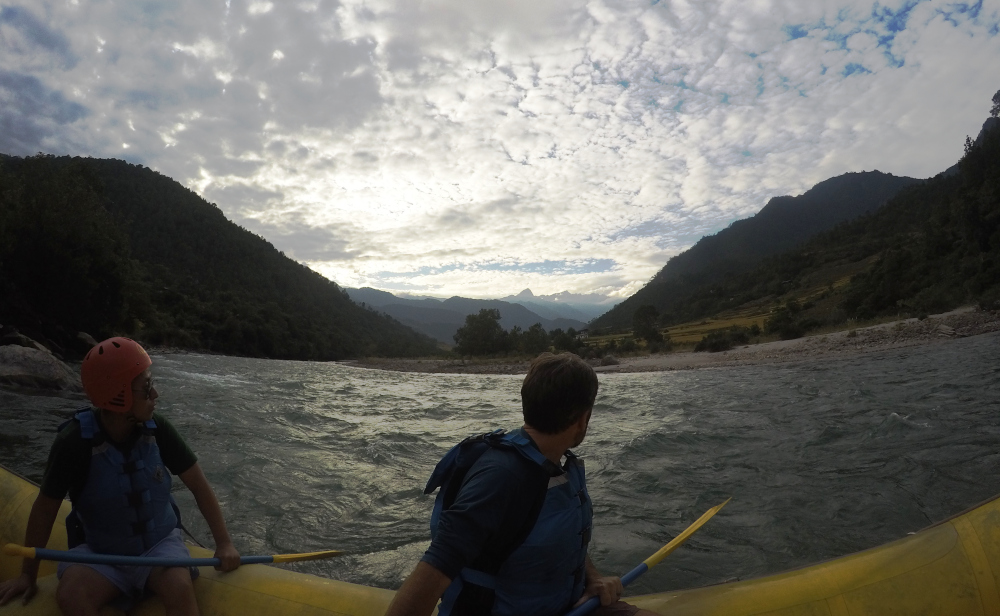
In Paro we made a visit with our guide to the National Museum, where we learned all about the history behind Bhutan’s many festivals that are held in different parts of the country throughout the year. We also learned about the traditional mask styles that are worn during their festival dances. Replicas of these masks are popular souvenirs and can be found for sale in many shops. After visiting the museum we walked down to see the Rinpung Dzong, another historic fortress and monastery, and its unique watchtower building.

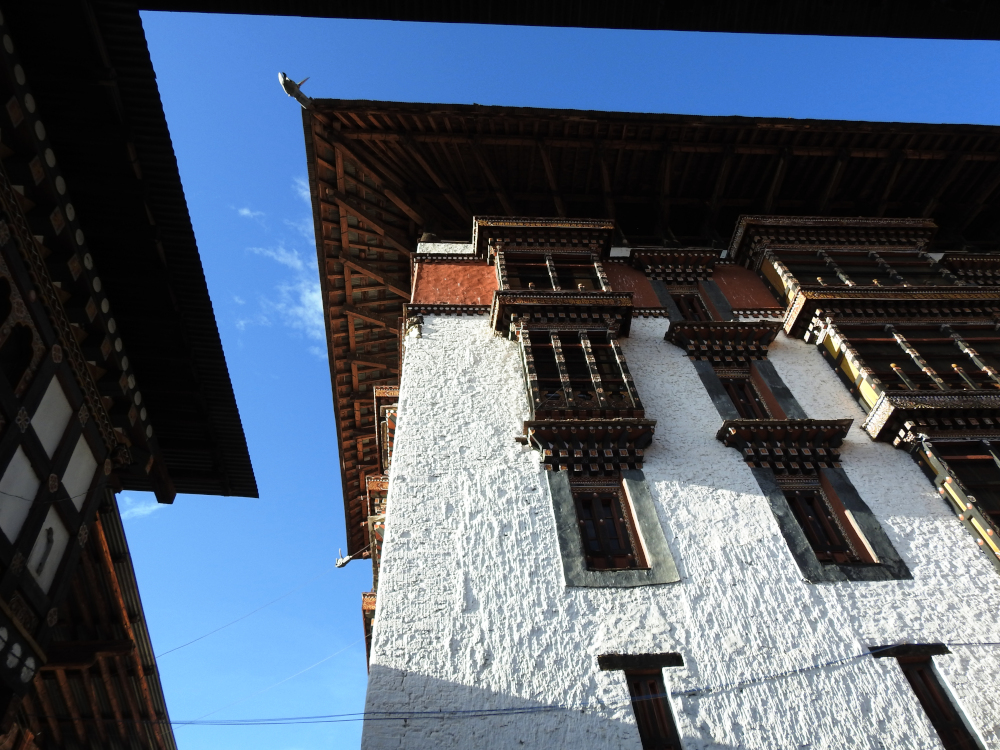
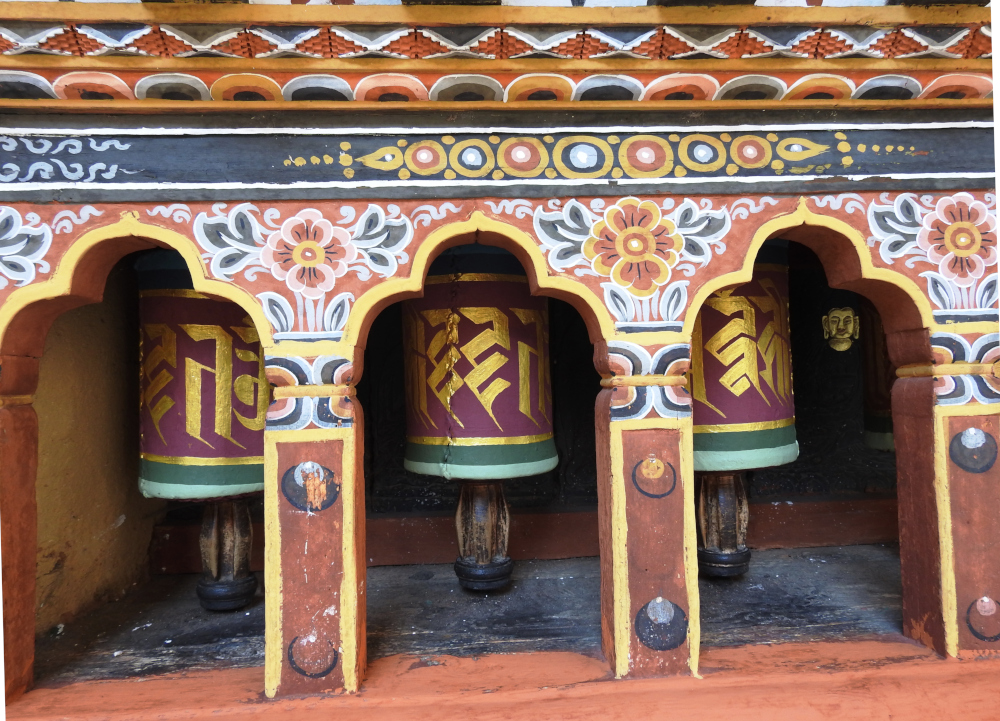
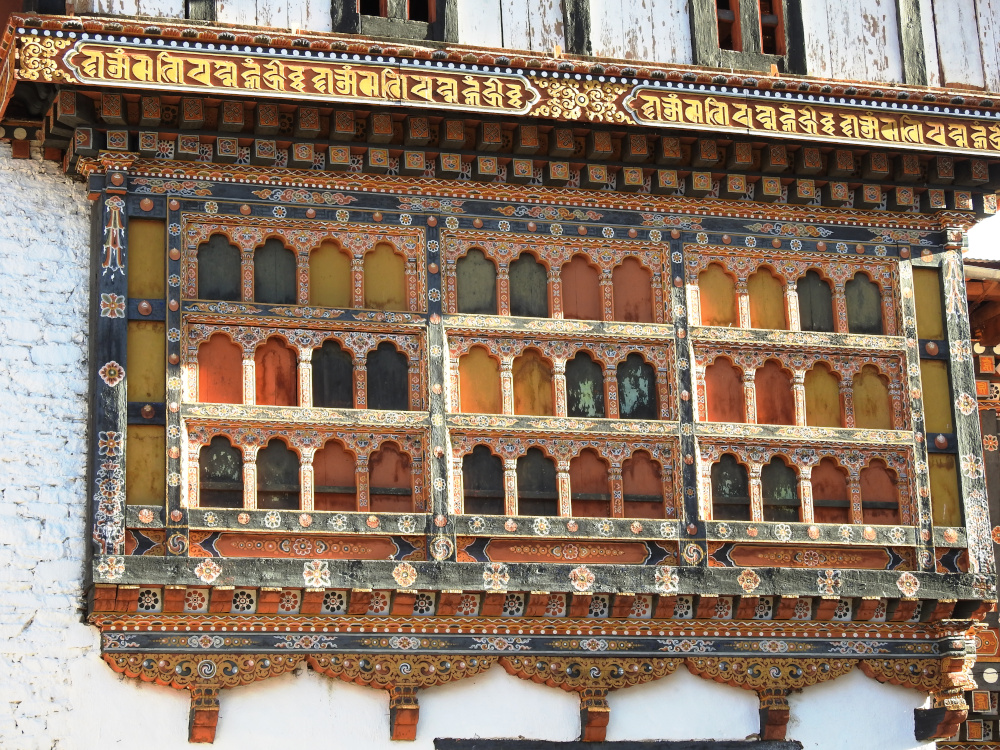
Almost every visitor to Bhutan wants to see Paro Taktsang, which is also known as the Tiger’s Nest Monastery. You can read about the legend behind the name here if you like. To reach the monastery perched high up on a cliffside requires a hike of about 5 miles roundtrip. There is an elevation gain of about 2,000 feet on the way up and the trail is quite steep in places. There are 700 stairs to descend and then 300 more to climb up to finally reached the monastery. It took us 2.5 hours from the trailhead to reach the top of the trail at the monastery.

Along the way there is absolutely gorgeous scenery. There is a cafeteria at the halfway point where you can stop for a snack or some tea. There are different views of Tiger’s Nest as the trail climbs as well as many prayer flags and a few prayer wheels. I was impressed with the people of all different ages and fitness levels making the trek up the mountain. It was not an easy hike. Some people choose to only go halfway up to get a nice view and some photos.

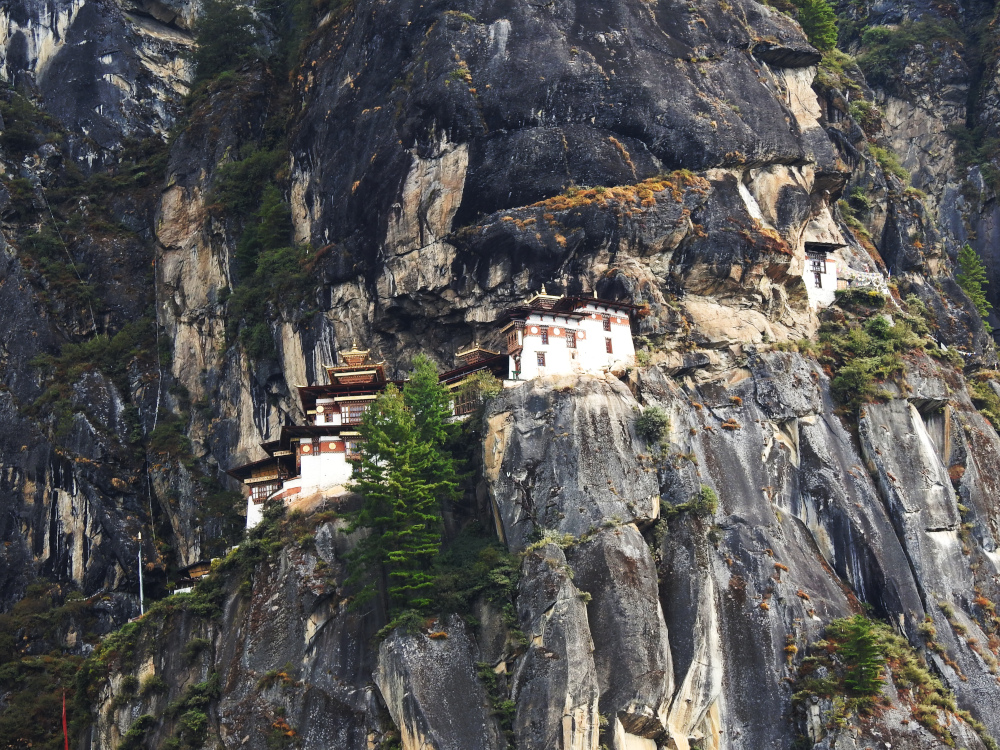
Once we reached the monastery we had to check our backpacks into a locker as cell phones, walking sticks, food, and cameras of any sort are all strictly forbidden inside. You also have to remove your shoes of course. There are ten temples that can be explored by visitors as well as a cave. We started our trek early at about 7:30 am and were thrilled to have several of the temples inside all to ourselves. Our guide explained a bit about each temple and then walked us down a tricky series of ladders to the dark cave that is said to be the nest where the tiger from the legend of Tiger’s Nest once lived. The views from inside the monastery were just amazing. After visiting the monastery we had to walk back down the way we came, which took us about an hour and 20 minutes. It was quite warm outside and most pleasant weather for the hike.
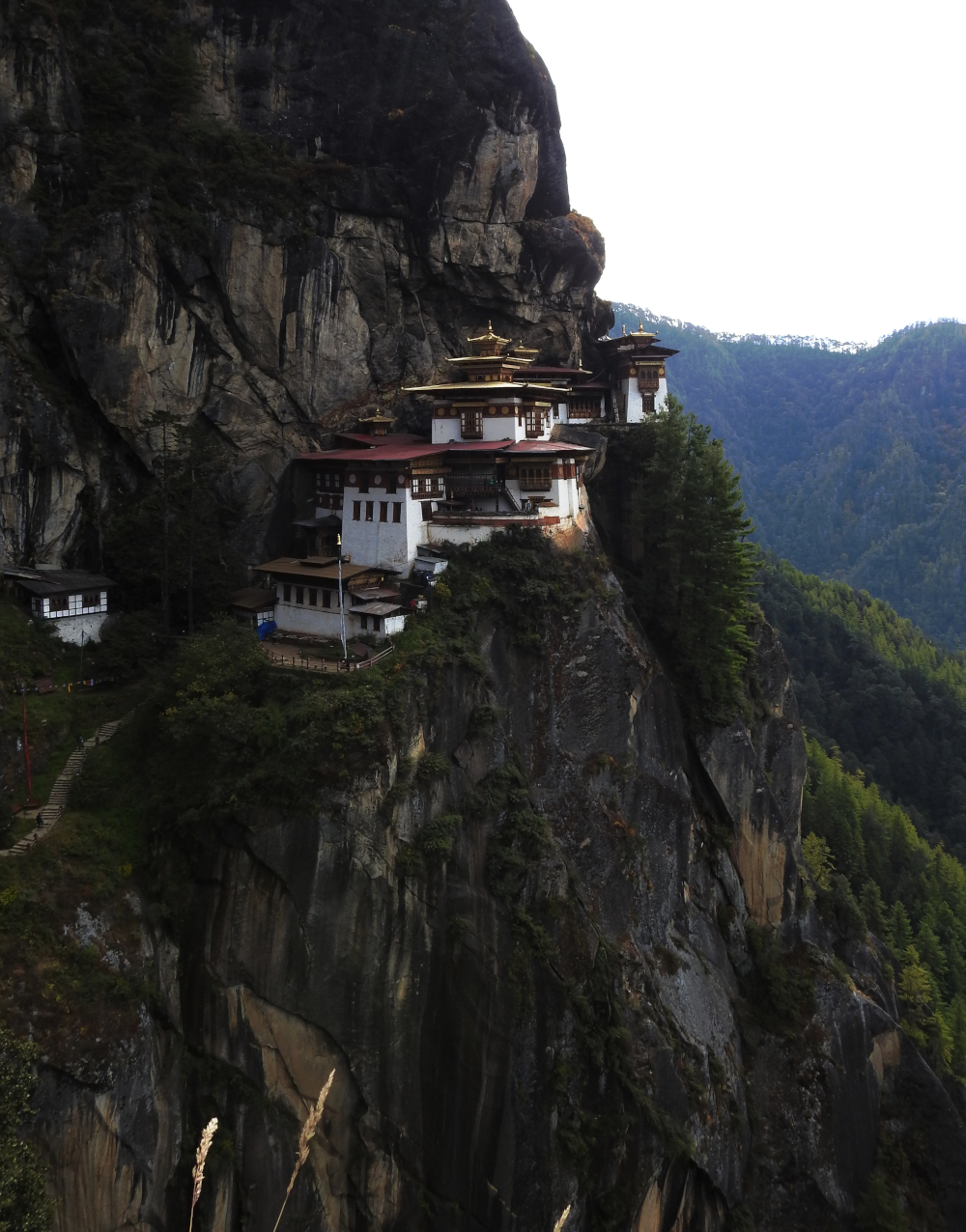
After our visit to Tiger’s Nest our guide took us for a short tour of Bhutan’s oldest temple Kichu Lhakang. It was built in the 7th century by the Tibetan Emperor Songtsen Gampo who is said to have built 108 Buddhist temples in his lifetime. 108 is a sacred number that appears frequently in Buddhism.
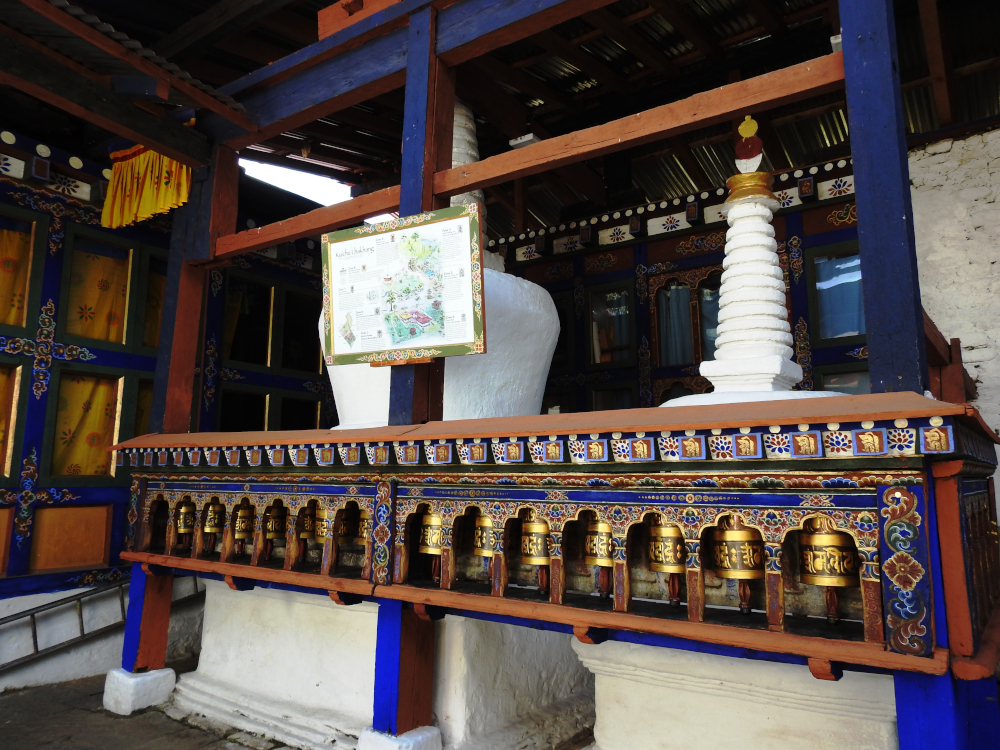
For dinner on our last evening in Bhutan we enjoyed dinner with Sonam and Khundhu at a local farmhouse in Paro. We sat on cushions on the floor in a big room and were served local rice wine in tiny cups when we arrived. We were also offered butter tea, which we did not try but is supposed to be a local favorite. We were then served an outstanding family style meal. In Bhutan they usually put chili cheese in their curries but they made us a special batch of pumpkin curry with chilis and no cheese.

We found the food in Bhutan to be quite enjoyable with plenty of vegetable dishes offered. Most of our meals were eaten at buffet style restaurants our guide took us to that seemed to be designed just for tourists which would not have been our usual preference but we ate quite well the entire trip so we had no complaints about food.
Hunting and fishing (except for catch and release) are illegal in Bhutan and all their meat for food is imported from India. There are signs along the road that encourage drivers not to harm animals to promote good karma. Cows often walk in the middle of the road clearly not afraid in the least of being hit by a car. Our driver always just went around them paying them little mind. There is also a large population of stray dogs that seem to live a carefree and well fed existence all over the country. They are known as “solar dogs” for their habit of lying about in the sun all day and then barking and running about at night.
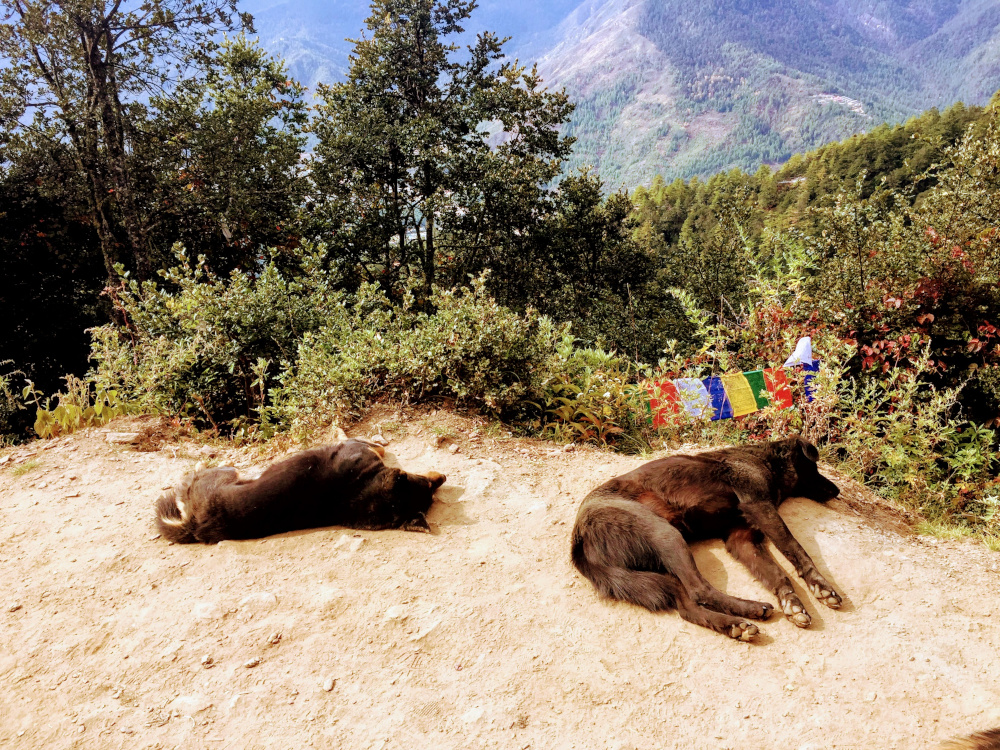
Bhutan is admired for their use of the gross national happiness philosophy to guide the country. An index that measures the collective happiness and well-being of the population is used to guide the country’s decisions and policies. The country is 90% Buddhist and spirituality is central to life for most people. They are quite protective of their culture and most men, women, and children still wear their unique traditional dress.
Life seems to move at a slower place in Bhutan. There are no traffic lights in the country as there is not all that much traffic. With its unspoiled landscapes, strong spirituality, unmaterialistic lifestyle, and almost nonexistent crime, it is not hard to understand why Bhutan is known as the land of happiness. The Bhutanese people seem to be enjoying life in the slow lane with an exceptional quality of life and peace of mind.

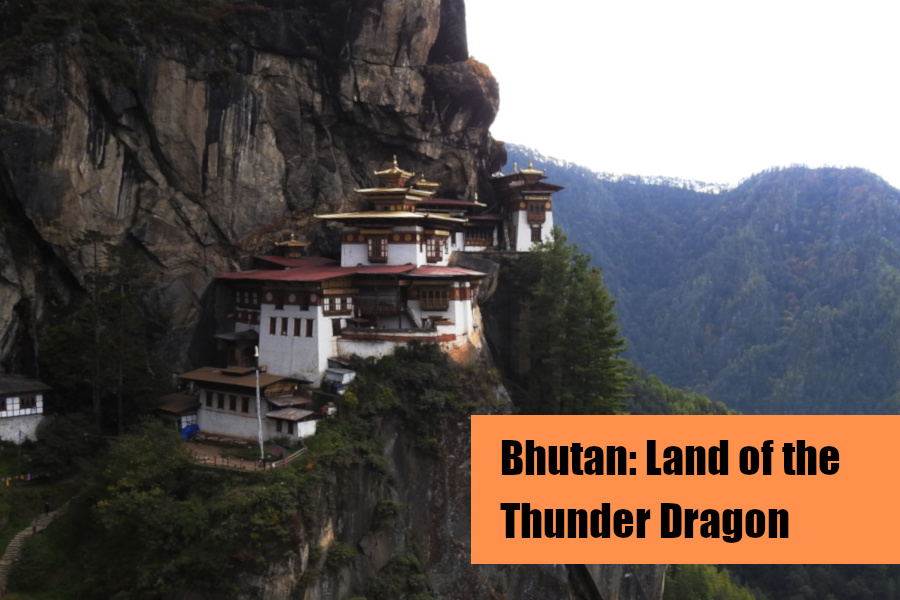
Wonderful account of an idyllic country 🇧🇹